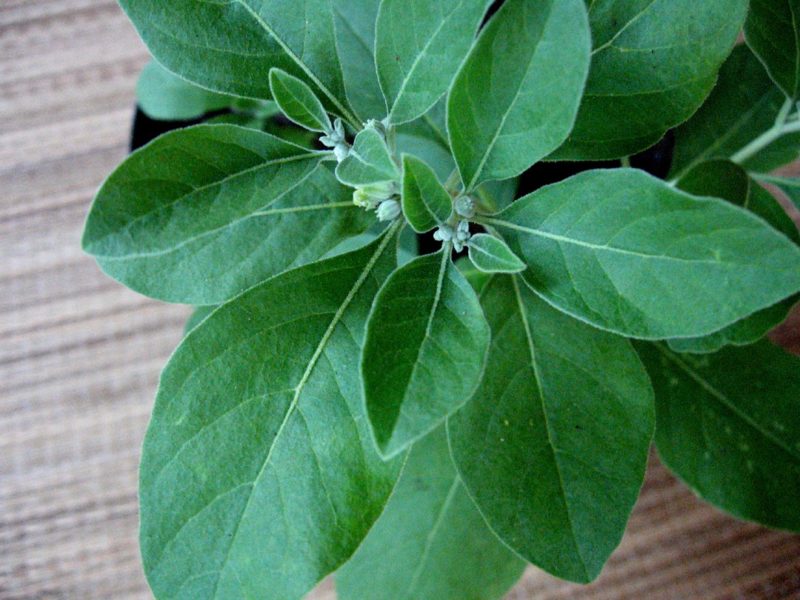The tropical regions of the Americas have always been fertile ground for exotic plants from around the world. Here’s one from India that many herbalists and health seekers may know. It’s called Ashwagandha (Withania somnefera).
In India, the use of ashwagandha dates back 3,000 years: it appears in ancient Ayurvedic texts and is renowned for its rejuvenating tonic effects and benefits to the nervous system.
Ashwagandha is a bushy plant from the nightshade family (along with tomatoes and eggplant). Its light-green leaves resemble eggplant leaves, but smaller. The small, yellow flowers bloom in the apex of the stems and later turn into small, orange berries full of tiny seeds. Ashwagandha is a plant which takes almost one year to produce mature roots, but the seeds can be harvested during most of the plant’s growth until maturity.
Because ashwagandha is a wild plant, it grows well on a wide variety of tropical soils and require minimum fertility. Of course, boosting its growth and vigor can be achieved with natural fertilizers, like compost tea and foliar sprays. In my trials at home, the plants also seem to have little or no problems with the bugs.
Indian researchers began to study ashwagandha’s medicinal properties in the 1950s and found that it had a positive impact on nervous disorders including insomnia, stress, hypertension and inflammation of the joints. Ashwagandha was also compared to Chinese ginseng and was found to have comparable anti-stress activity and anti-oxidative and anti-inflammatory properties, as well as an aphrodisiac effect.
Today, more than 200 studies have confirmed that ashwagandha can reduce the effects of stress, improve learning and memory, reduce anxiety and depression, stabilize blood sugar levels, help to lower cholesterol, reduce inflammation, protect the immune system, as well as enhancing sexual potency in both men and women.
The roots can be dried and powdered to make teas or tinctures. The tea is safe and non-toxic, but the small, tomato-like berries have been reported to cause gastroenteritis in children. The typical recommended dose is 600 to 1,000 mg twice daily. For people who suffer from insomnia and anxiety, having a cup of hot milk that contains a teaspoon of powdered ashwagandha before bedtime is beneficial.
We were lucky to obtain ashwagandha seeds last year, and our new seedling plants are thriving. Here’s what we have learned so far on how to grow them at home. First off, the seeds are very small and need to be started in flats with prepared potting soil for optimal results. The seeds take 20 days or more to germinate, so be patient. The young seedlings take about a month before they can be transplanted to pots. I’d suggest you plant them in 12-inch pots with a mix of 4 parts strained compost and 1 part sand.
Once your first plants start producing seeds, you can create hundreds of new plants that can be planted around the home or in an herb garden.
Mature roots can be harvested, then washed and sliced to dry in the sun for several days. These chips can then be stored in a glass jar for future use as a tea. The powdered root can be preserved in alcohol as a convenient tincture. Add 50 grams of powder to 1 liter of clear rum for tincture. Shake the bottle once or twice a day until the tincture is ready in about 10 days.
Source: http://www.ticotimes.net/2017/04/29/move-ginseng-comes-ashwagandha
What's the REAL problem with Ashwagandha?
Eventhough Ashwagandha comes with a laundry list of incredible health benefits:
- Supports Healthy Thyroid Function
- Promotes a Calm State of Mind
- Improves Mood and Energy
- Boosts Memory and Supports Brain Health
- Strengthen Immune Function
It has *one major flaw*.
The major flaw of Ashwagandha is bioavailability.
The body has a hard time absorbing Ashwagandha Powder, which makes bioavailability a HUGE issue! Bioavailability is the amount of a substance that enters your bloodstream. More bioavailability means you actually get the health benefits you’re looking for. But less bioavailability? That means you’re wasting money.
Essence Roots has discovered a unique, yet simple way to make Ashwagandha more bioavailable than ever.
Along with giving us superstar nutrients like ashwagandha, Mother Nature also provides us with helper nutrients. These helper nutrients take a good thing and make it even better. Scientists call these Bioavailability Enhancers, and new research points to piperine as being the most effective on the planet. Ultra Ashwagandha comes in a veggie capsule packed full of piperine, making it the most bioavailable Ashwagandha money can buy!
Special Offer
Today Ultra Ashwagandha by Essence Roots is running a 50% off promotion. The more bottles you buy, the more discount you get. So don’t wait until its too late, take advantage of this incredible offer now. Don’t forget to come back and let us know about your results!
Simply click on the link bellow to claim your deal.

This is a one time purchase with no hidden additional cost or obligations.



